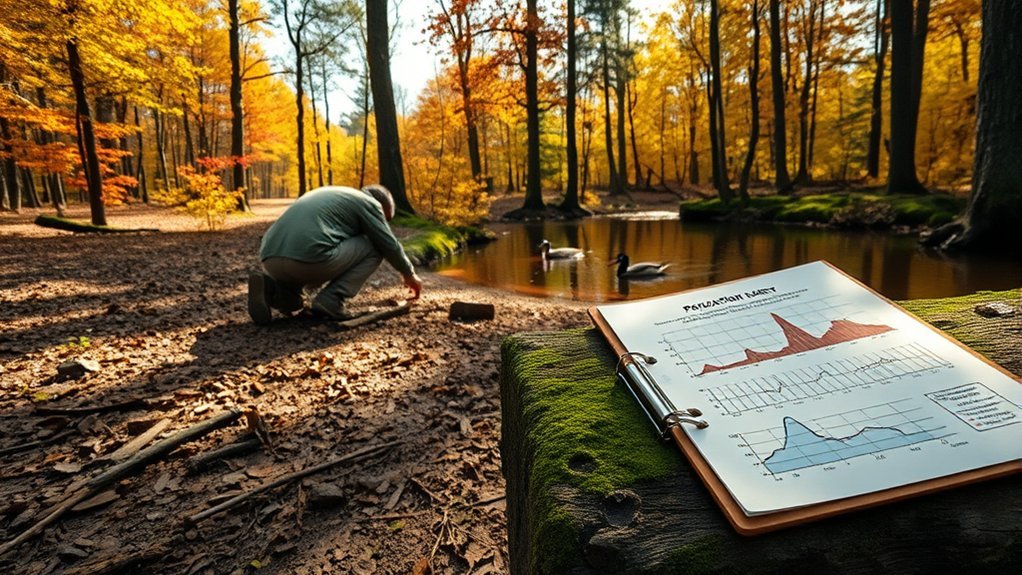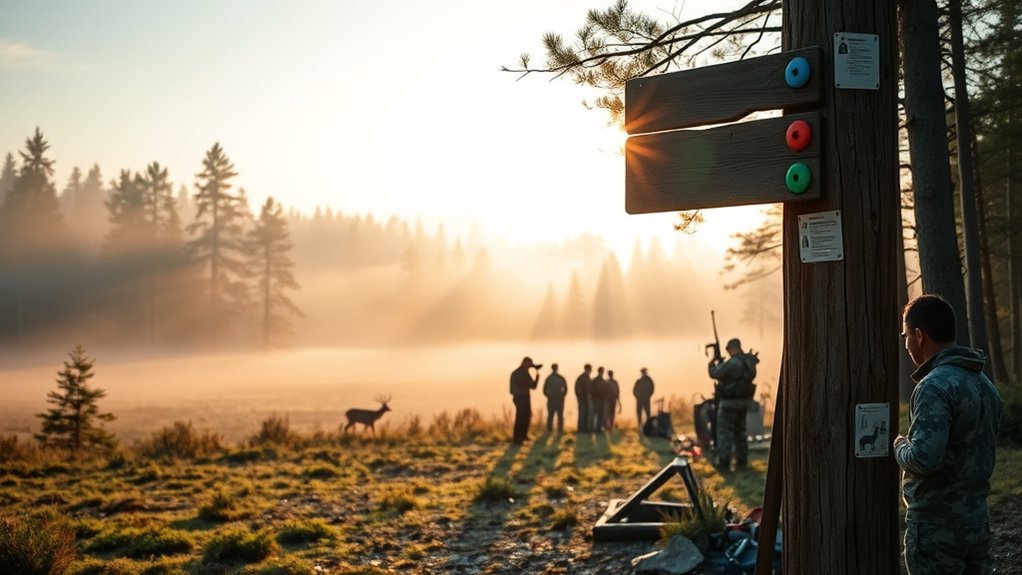When it comes to determining hunting seasons, a careful orchestration of ecological factors is at play. Wildlife biologists meticulously analyze population dynamics, reproductive cycles, and habitat conditions to guarantee balance in ecosystems. By examining various data sources, they establish guidelines that align both conservation efforts and recreational needs. To understand the complexities involved in this process and the implications of these regulations, it’s essential to explore how these decisions are made and who influences them.
The Role of Wildlife Biologists

While you may think of hunting seasons as simply a set of dates on a calendar, wildlife biologists play an essential role in determining these timelines. They study population dynamics, reproductive cycles, and habitat conditions to guarantee sustainable wildlife management. By analyzing factors such as birth rates, mortality rates, and environmental changes, biologists assess species health and viability. This data informs decisions on when to open or close hunting seasons, balancing ecological integrity with recreational opportunities. They also consider human impact and compliance with conservation laws. Ultimately, their work aims to maintain biodiversity while allowing hunters to engage responsibly. Without their scientific expertise, hunting seasons could jeopardize wildlife populations and disrupt ecosystems.
Data Collection and Analysis

As wildlife biologists gather data on animal populations, they employ a variety of methods to secure accurate and reliable results. They often use techniques such as aerial surveys, camera traps, and field observations to monitor species density and distribution. You might find biologists analyzing habitat conditions and food availability alongside population counts to create a thorough picture. Statistical models play a vital role, helping to interpret the data and predict future population trends. Additionally, they may incorporate citizen science reports to expand their data set. By utilizing a combination of quantitative and qualitative methods, biologists make certain that their findings reflect true population dynamics, providing a solid foundation for setting hunting seasons and promoting sustainable wildlife management.
Population Dynamics and Health

To effectively manage wildlife populations, you need to employ robust monitoring techniques that track changes in animal numbers and distribution. Understanding the health of these populations through wildlife health assessments is essential, as it informs you about disease prevalence and environmental impacts. Together, these approaches help guarantee sustainable hunting practices and maintain ecological balance.
Population Monitoring Techniques
Effective population monitoring techniques are essential for understanding wildlife dynamics and health, especially when setting hunting seasons. You’ll often encounter methods like aerial surveys, which provide a broad overview of animal distribution and density. Ground counts can give you detailed insights into specific populations, while camera traps offer non-invasive monitoring of wildlife behavior and numbers. Genetic sampling adds another layer, allowing you to assess genetic diversity and population structure. Additionally, telemetry can track animal movements and habitat use, revealing critical information about their ecological needs. By integrating these techniques, you can obtain a thorough picture of population trends, ensuring sustainable management and informed decision-making for hunting regulations. Each method contributes uniquely to the overall understanding of wildlife populations.
Wildlife Health Assessments
Understanding the health of wildlife populations is fundamental for effective management and conservation efforts. You’ll want to evaluate various factors, including disease prevalence, nutritional status, and reproductive success. Regular monitoring helps identify trends that may indicate population stress or decline. For instance, you might analyze blood samples to detect pathogens or parasites affecting survival rates. Moreover, evaluating habitat quality informs you about the availability of resources essential for sustaining populations. By integrating these health assessments into population dynamics studies, you can develop targeted management strategies. Ultimately, maintaining healthy wildlife populations guarantees ecological balance and supports sustainable hunting practices, which are crucial for both conservation and community engagement.
Habitat Conditions and Ecosystem Factors
When evaluating hunting seasons, you must consider how weather patterns impact habitat conditions and food availability. Variations in temperature and precipitation can greatly influence plant growth and animal behavior, affecting the overall ecosystem. Understanding these dynamics helps you anticipate shifts in wildlife populations and make informed decisions about hunting regulations.
Weather Patterns Impact
Although weather patterns can seem unpredictable, their influence on habitat conditions and ecosystem factors is both significant and measurable. Changes in temperature and precipitation directly affect soil moisture, plant growth, and overall habitat stability. For instance, a wetter season may lead to increased vegetation density, which can alter animal movement and breeding behaviors. Conversely, prolonged droughts can stress ecosystems, reduce habitat quality, and make animals more vulnerable to predation. These shifts impact not only the distribution of species but also their reproductive cycles. Understanding these weather-driven changes is essential for wildlife managers, as they help set hunting seasons that align with wildlife population health and ecosystem balance. Effective management relies on recognizing these patterns to guarantee sustainable hunting practices.
Food Availability Trends
Food availability trends play an essential role in determining wildlife populations and their behaviors. As you observe ecosystems, you’ll notice that fluctuations in food resources, driven by seasonal changes and habitat conditions, directly influence animal movements and reproductive cycles. For instance, during abundant acorn seasons, deer populations might experience a population surge due to increased nutrition. Additionally, the availability of forage affects predator-prey dynamics; when prey is scarce, predators may expand their territories, impacting hunting regulations. Habitat degradation can lead to food shortages, forcing wildlife to adapt or migrate. By analyzing these trends, wildlife managers can set hunting seasons that align with population health and sustainability, ensuring that hunting practices remain responsible and ecologically sound.
Community Involvement and Stakeholder Input
As stakeholders actively engage in the process of setting hunting seasons, their insights can markedly shape wildlife management strategies. You’ll find that community input often reflects local ecological knowledge, highlighting species behavior, population dynamics, and habitat conditions. Engaging hunters, conservationists, and landowners fosters a thorough view of wildlife health, ensuring decisions are data-driven and contextually relevant. Feedback mechanisms, such as public forums or surveys, facilitate dialogue, allowing you to weigh diverse opinions against scientific research. This collaborative approach not only enhances trust but also promotes stewardship among community members. By incorporating stakeholder perspectives, wildlife agencies can tailor regulations that balance conservation goals with recreational needs, ultimately leading to sustainable hunting practices that benefit both wildlife populations and local economies.
Regulatory Framework and Enforcement
The regulatory framework governing hunting seasons is essential for ensuring that wildlife populations are managed sustainably while balancing the interests of various stakeholders. You’ll find this framework includes laws, regulations, and guidelines established by wildlife agencies at state and federal levels. These rules dictate the timing, methods, and species allowed for hunting, based on scientific data and population studies. Enforcement of these regulations relies on trained personnel who monitor compliance, investigate violations, and conduct outreach to educate hunters. Fines and penalties for infractions reinforce the importance of adherence. By integrating scientific research with regulatory oversight, the framework aims to maintain ecological balance while accommodating recreational and economic interests, ensuring a sustainable future for both wildlife and hunting communities.
Conclusion
At its core, setting hunting seasons isn’t merely a game of chance; it’s a carefully orchestrated symphony where wildlife biologists play the conductor. By harmonizing data collection, population dynamics, and community insights, they guarantee a sustainable balance between conservation and recreation. Just as nature’s cycles ebb and flow, so too must our hunting practices adapt. Ultimately, this meticulous process safeguards both wildlife and our outdoor heritage, fostering a future where both can thrive in harmony, echoing the age-old dance of life.

